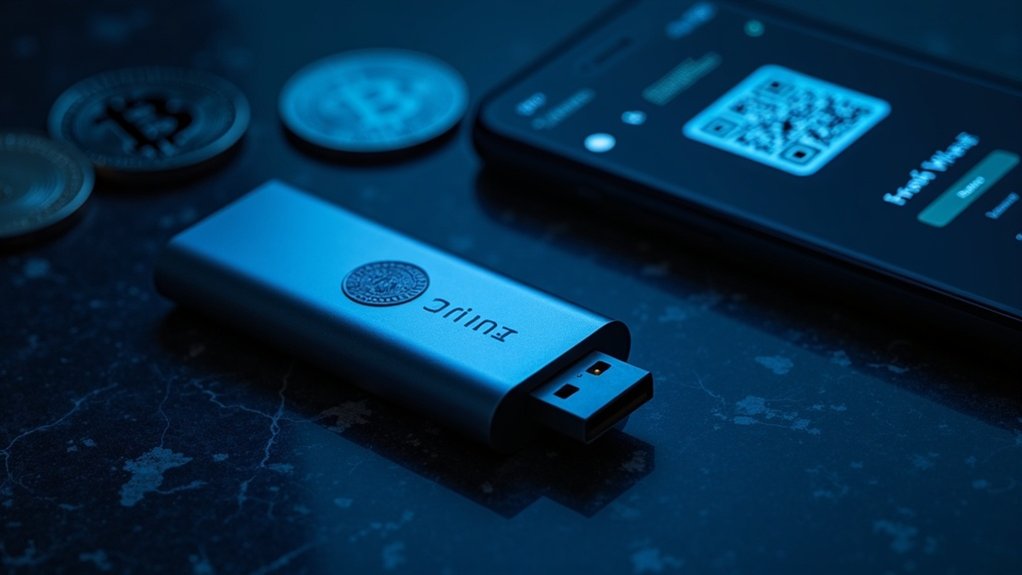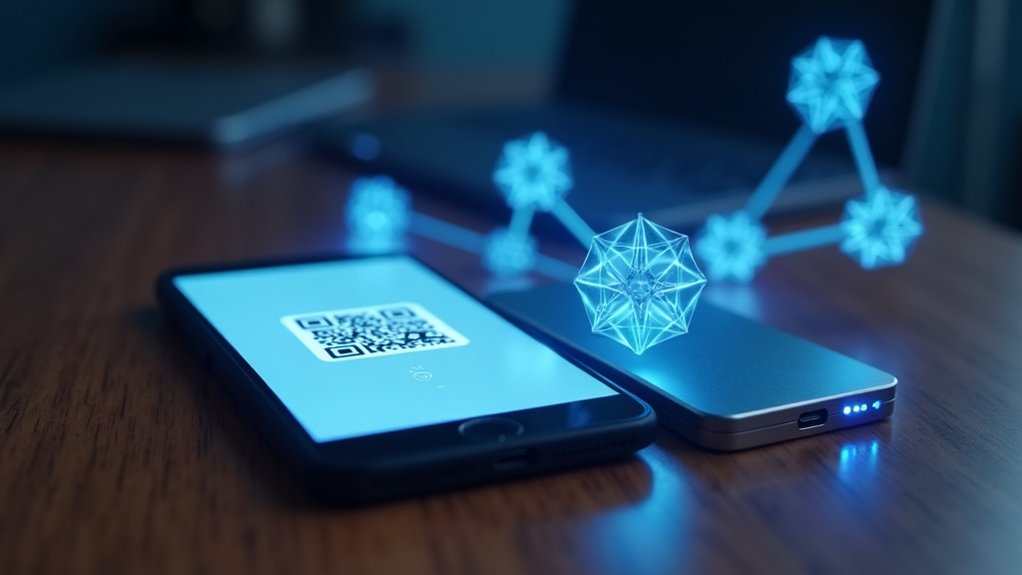Cold wallets are offline cryptocurrency storage devices that keep private keys completely isolated from the internet. They work by signing transactions offline before sending the authenticated signature back to connected devices. No hackers, no malware, no problems. These physical devices require PINs or biometrics for access and remain immune to remote attacks. Popular hardware options include Ledger and Trezor. Serious investors trust them for significant holdings. The security difference is night and day compared to online alternatives.
A cold wallet isn’t your typical crypto storage solution – it’s a fortress.
Unlike standard wallets, cold wallets remain completely disconnected from the internet, giving users total control over their private keys while keeping them safely offline.
Cold wallets stay 100% offline, giving you complete control while keeping your private keys away from digital threats.
These keys – the secret codes proving cryptocurrency ownership – stay tucked away from prying digital eyes.
No internet connection means dramatically reduced risk of hacking.
Simple as that.
The transaction process with cold wallets is methodical.
First, you prepare your transaction on an internet-connected device.
Next, transfer those details to your cold wallet via QR code or USB.
The cold wallet signs the transaction offline – where hackers can’t reach – and sends the signed details back to your online device for blockchain broadcasting.
The private keys never touch the internet.
Not even for a second.
Security advantages? Massive.
Your private keys remain isolated on the device, safe from malware lurking on your computer.
Someone steals your physical wallet? Good luck to them.
Most devices require PINs, seed phrases, or biometric verification.
Some even offer passphrase functionality – an extra secret word that adds another security layer.
Phishing attacks? Remote hacking? Not happening with cold storage.
Cold wallets come in various forms.
Most are hardware devices resembling thumb drives or encrypted cards.
Some feature OLED displays for transaction verification.
Others use multi-component systems requiring separate physical elements to access.
Many are open-source, ensuring continuity even if manufacturers disappear.
Popular hardware options like Ledger Nano X offer secure chip technology for maximum protection.
Who needs them? Anyone with significant crypto holdings or plans for long-term storage.
Institutions and serious investors rely on them for securing digital assets.
They’re not convenient for daily trading – that’s the trade-off.
Security versus convenience.
Many users pair cold wallets with hot wallets, keeping small amounts online for convenience while their wealth stays locked in cold storage.
The bottom line: cold wallets keep your crypto safe by staying offline.
In the wild west of cryptocurrency, that’s no small thing.
For businesses handling client assets, cold wallets help meet regulatory requirements for safeguarding digital funds.
Cold wallets also avoid smart contract interactions, protecting users from the $2.7 billion lost to malicious contract scams in 2022.
Frequently Asked Questions
How Much Does a Cold Wallet Typically Cost?
Cold wallets typically cost between $50 and $200. Entry-level hardware wallets start around $50-60, while established brands like Ledger or Trezor run $100-150.
Want fancy features? Expect to pay over $150.
Paper wallets are basically free, if you’re into that whole DIY security thing.
Metal seed storage devices—those fancy backup solutions—range from $20-100.
Pretty reasonable considering they’re protecting your digital fortune from hackers.
Security has a price tag, folks.
Can a Cold Wallet Be Hacked Remotely?
No, cold wallets cannot be hacked remotely.
Their entire purpose is keeping private keys offline and disconnected from the internet.
No internet connection means no remote attack path.
Period.
Hackers might try indirect methods though.
Malware on connected computers.
Phishing for seed phrases.
Supply chain tampering.
Bluetooth vulnerabilities in certain models.
But the direct, traditional “hack your online wallet” scenario?
Physically impossible.
That’s literally why people use these things in the first place.
What Happens if I Lose My Cold Wallet?
Losing a cold wallet isn’t the end of the world—unless you’ve lost your seed phrase too. Then you’re screwed.
With the seed phrase intact, simply buy a new compatible wallet and restore your funds during setup.
No phrase? Those crypto assets are likely gone forever. Permanently.
Some recovery services exist for partial password info, but success isn’t guaranteed and costs add up fast.
Cold wallets are secure from hackers, sure, but absolutely vulnerable to human error.
Do I Need Technical Knowledge to Use a Cold Wallet?
Some technical know-how is definitely required for cold wallets. Basic users can handle hardware wallets with their guided setup processes.
But there’s no getting around it—you need to understand seed phrases, offline transaction signing, and proper backup procedures. Paper wallets? Those demand even more technical skills.
The interfaces are getting more user-friendly, sure. But mess up the setup or recovery steps? Your crypto might vanish forever. Not exactly plug-and-play technology.
Can I Recover Funds Without My Recovery Phrase?
No. Period. End of story.
Without the recovery phrase, crypto funds in a cold wallet are basically gone forever.
There’s no “forgot password” button in crypto.
The math behind it makes recovery virtually impossible—like finding a specific grain of sand on a beach.
Some “recovery services” exist, but they’re usually scams.
Hardware still intact? Doesn’t matter.
That recovery phrase is the only key to the kingdom.









